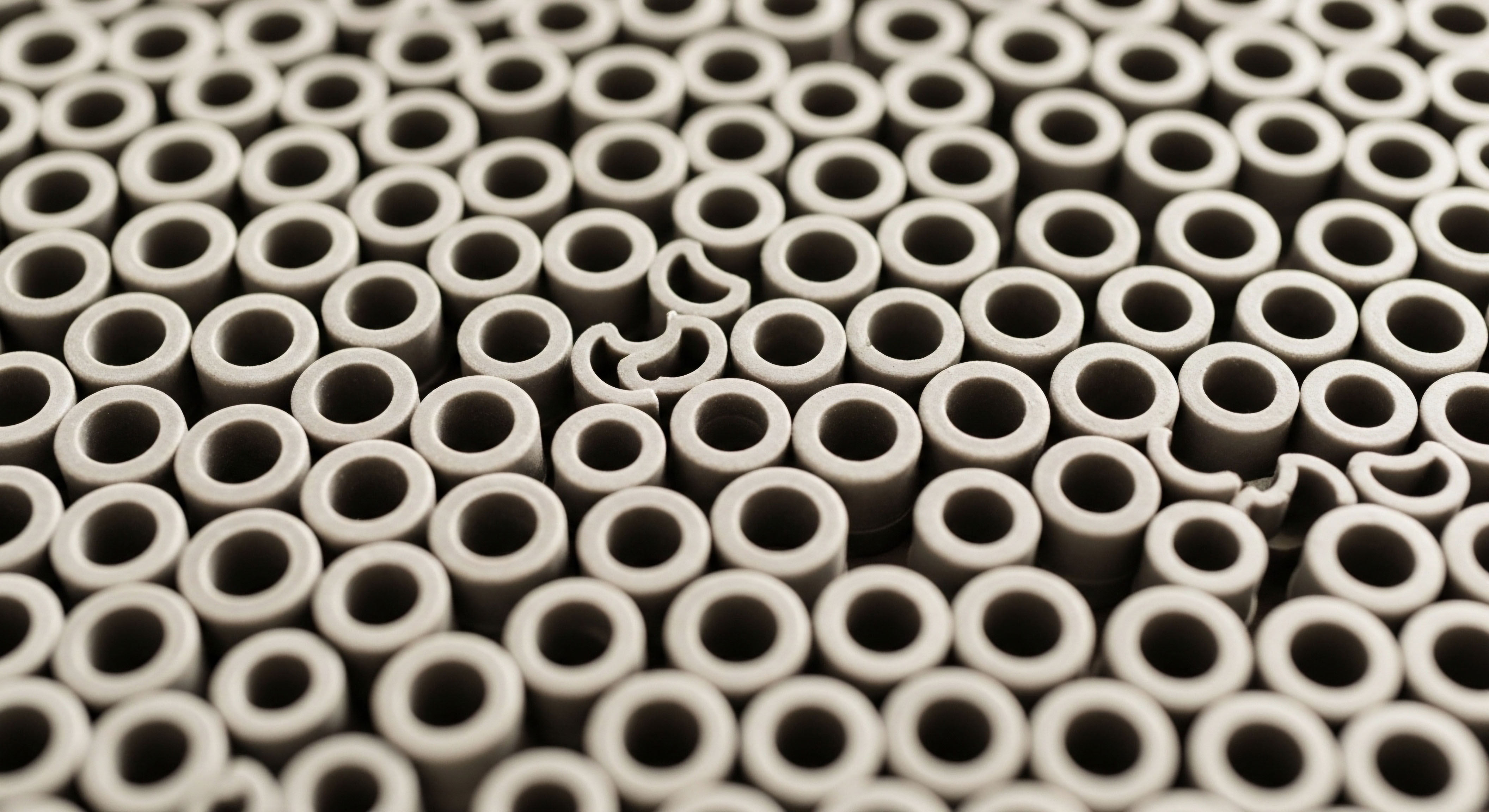

Fundamentals
You are here because something feels off. Perhaps it is a persistent fatigue that sleep does not touch, a subtle but insistent change in your mood, or the sense that your body is no longer responding the way it once did. These experiences are valid.
They are the subjective signals of deep biological shifts within your endocrine system, the intricate communication network that governs your vitality. When you begin a clinical protocol like hormone therapy, you are initiating a conversation with this system. The efficacy of that conversation, however, depends entirely on the environment in which it takes place.
Your lifestyle constitutes this environment. The food you eat, the quality of your sleep, your physical activity, and your management of stress are the powerful inputs that can either amplify or mute the therapeutic signals you are introducing.
Understanding this dynamic begins with a clear picture of what hormones are and how they function. Think of hormones as precise molecular messengers, dispatched from endocrine glands and sent through the bloodstream with a specific directive for a target cell. Each target cell is studded with receptors, which are specialized docking stations.
When a hormone molecule binds to its corresponding receptor, it unlocks a specific action inside that cell. This elegant lock-and-key mechanism is the basis of all hormonal communication. Clinical hormone therapies provide the body with a supply of keys. Lifestyle factors, in turn, determine the condition and availability of the locks.
A system flooded with inflammatory signals from a highly processed diet, or one chronically exposed to the disruptive effects of the stress hormone cortisol, will have fewer available or less responsive receptors. The therapeutic message, however potent, struggles to be heard.
Your body’s hormonal balance is a dynamic system, and clinical therapies work in partnership with the foundational inputs of your daily life.
This entire process is governed by sophisticated feedback loops, primarily managed by the brain. The hypothalamus and pituitary gland act as the master control centers. For instance, the Hypothalamic-Pituitary-Gonadal (HPG) axis governs reproductive and metabolic health in both men and women.
The hypothalamus releases Gonadotropin-Releasing Hormone (GnRH), signaling the pituitary to release Luteinizing Hormone (LH) and Follicle-Stimulating Hormone (FSH). These hormones then travel to the gonads (testes in men, ovaries in women) to stimulate the production of testosterone and estrogen.
The circulating levels of these hormones are monitored by the brain, which then adjusts its own signals to maintain equilibrium. Chronic stress or poor nutrition can disrupt this central command, forcing the system to down-regulate its own production and making it less receptive to external support from therapies.

The Cellular Environment
The success of any hormonal optimization protocol is decided at the cellular level. Every cell in your body is encased in a membrane, a fatty bilayer that is profoundly influenced by your diet. The types of fats you consume become the literal building blocks of these membranes, affecting their fluidity and the function of the receptors embedded within them.
A diet rich in omega-3 fatty acids, found in sources like fatty fish, supports supple and responsive cell membranes. Conversely, a diet high in processed trans fats and excessive omega-6 fatty acids can create cellular stiffness, impairing the ability of hormones to dock with their receptors. This is a foundational concept. The therapy can deliver a perfect hormonal signal, but if the cellular hardware is compromised, the message will not be received with fidelity.
Furthermore, the internal environment of the cell is just as important. All cellular processes, including the translation of a hormonal signal into a biological action, require energy in the form of ATP (adenosine triphosphate). This energy is produced by the mitochondria, the powerhouses of the cell.
Mitochondrial function is directly supported by nutrient-dense foods, regular physical activity, and adequate rest. Lifestyle factors that induce high levels of oxidative stress, such as chronic psychological stress, exposure to environmental toxins, or a diet lacking in antioxidants, damage mitochondria.
This bioenergetic deficit compromises every system in the body, including the endocrine system’s ability to effectively utilize therapeutic hormones. A body struggling with an energy crisis at the cellular level cannot fully implement the instructions provided by a sophisticated hormonal protocol.

Hormone Synthesis and Precursors
Your body manufactures hormones from raw materials obtained from your diet. Cholesterol, a molecule often viewed negatively, is the foundational precursor for all steroid hormones, including testosterone, estrogen, progesterone, and cortisol. A diet severely deficient in healthy fats can limit the available substrate for hormone production, creating a system-wide deficit. Beyond the primary building blocks, specific micronutrients are indispensable cofactors in the enzymatic pathways that convert these precursors into their final, active forms.
Consider the following essential nutrients:
- Zinc ∞ This mineral is vital for the production of testosterone. It plays a role in the function of the pituitary gland, influencing the release of LH, the direct signal for testosterone synthesis in the testes.
- Magnesium ∞ Involved in hundreds of enzymatic reactions, magnesium helps regulate the HPA axis, mitigating the impact of cortisol. It also plays a role in optimizing free testosterone levels by influencing Sex Hormone-Binding Globulin (SHBG).
- Vitamin D ∞ Functioning as a pro-hormone itself, Vitamin D receptors are found on cells throughout the body, including in the endocrine glands. Adequate levels are associated with healthier testosterone production and improved insulin sensitivity.
- B Vitamins ∞ This family of vitamins is crucial for cellular energy production and the methylation processes that help clear used hormones from the body, preventing their harmful accumulation.
A lifestyle that leads to nutritional deficiencies places a significant burden on the endocrine system. When you introduce a clinical therapy, you are asking this system to manage and respond to a new set of powerful signals. Providing it with the fundamental resources it needs to function is a prerequisite for success. You are preparing the soil before planting the seed.


Intermediate
Moving beyond foundational concepts, we arrive at the specific, tangible interactions between your daily choices and the clinical protocols designed to restore hormonal equilibrium. When a physician prescribes Testosterone Cypionate for a man, or a combination of Testosterone and Progesterone for a woman, they are initiating a precise biochemical intervention.
The success of this intervention is modulated by a series of physiological variables that you directly control. These variables determine not just the perceived benefits of the therapy but also the management of potential side effects and the overall sustainability of the protocol.
One of the most significant modulators is your body’s management of blood sugar and insulin. Insulin is a powerful hormone in its own right, and its relationship with sex hormones is deeply interconnected. Chronic high insulin levels, a condition known as hyperinsulinemia often resulting from a diet high in refined carbohydrates and a sedentary lifestyle, can have profound consequences for hormonal balance.
In men, high insulin can suppress the production of Sex Hormone-Binding Globulin (SHBG) by the liver. Since SHBG binds to testosterone in the bloodstream, lower SHBG levels can initially seem beneficial by increasing “free” testosterone. However, this state is often accompanied by increased activity of the aromatase enzyme, which converts testosterone into estradiol.
This can lead to an unfavorable testosterone-to-estrogen ratio, undermining the goals of TRT and potentially causing side effects. For women, particularly those with conditions like Polycystic Ovary Syndrome (PCOS), insulin resistance is a primary driver of excess androgen production, and managing it is a critical component of restoring balance.

The Aromatase Engine Body Composition and Estrogen Management
In many male hormone optimization protocols, a key objective is to administer testosterone while carefully managing its conversion to estrogen. This is the purpose of medications like Anastrozole, an aromatase inhibitor. The aromatase enzyme is most abundantly found in adipose tissue, or body fat.
Consequently, an individual’s body composition is a primary determinant of their baseline level of aromatization. A higher body fat percentage means a larger “engine” for converting supplemental testosterone into estradiol. While some estrogen is vital for male health, contributing to bone density, cognitive function, and libido, excessive levels can lead to side effects such as water retention, gynecomastia, and mood changes.
Lifestyle choices that promote a healthier body composition therefore become a powerful adjunct to therapy. They directly reduce the physiological need for higher doses of aromatase inhibitors. These choices include:
- Resistance Training ∞ Building lean muscle mass increases the body’s metabolic rate and improves insulin sensitivity. Muscle is metabolically active tissue that helps partition nutrients away from fat storage.
- Strategic Nutrition ∞ A diet focused on protein adequacy, fiber, and nutrient-dense whole foods supports satiety and provides the building blocks for muscle while minimizing the caloric excess that drives fat storage.
- Consistent Physical Activity ∞ Regular cardiovascular exercise contributes to a negative energy balance and has been shown to improve the hormonal milieu, including the regulation of insulin and cortisol.
By focusing on improving body composition, an individual on TRT can create an internal environment where the administered testosterone is utilized more effectively for its intended anabolic and androgenic purposes, with a reduced propensity for estrogenic conversion. This biological reality illustrates how lifestyle becomes a primary tool for refining and optimizing a clinical protocol.
Managing blood sugar and body composition through diet and exercise directly influences how your body utilizes and converts therapeutic hormones.
What is the direct impact of sleep on hormone therapy? Sleep is a master regulator of the endocrine system. During deep sleep, the body performs critical repair processes and hormonal regulation. The pituitary gland, the master control center, is particularly active during this time, releasing pulses of hormones like Growth Hormone.
Chronic sleep deprivation, defined as consistently getting less than seven hours of quality sleep, disrupts the entire hormonal cascade. It elevates cortisol levels the following day, promoting insulin resistance and a catabolic state that can directly counteract the anabolic goals of testosterone or peptide therapies.
For men on TRT with Gonadorelin to support natural testicular function, sleep quality is paramount. The nocturnal pulsatile release of GnRH from the hypothalamus, which Gonadorelin mimics, is optimized during healthy sleep cycles. Insufficient sleep blunts this natural rhythm, making the entire HPG axis less responsive to therapeutic inputs.

Protocol Specific Lifestyle Integration
To understand the interplay between lifestyle and therapy, it is useful to examine specific clinical protocols and the lifestyle factors that most directly influence their outcomes.

Table of Hormone Therapies and Lifestyle Synergies
| Clinical Protocol | Primary Lifestyle Modulator | Mechanism of Influence |
|---|---|---|
| Male TRT (Testosterone Cypionate + Anastrozole + Gonadorelin) | Body Composition & Stress Management | Lower body fat reduces aromatase activity, decreasing the need for Anastrozole. Lower cortisol from stress management prevents suppression of the HPG axis, enhancing the effect of Gonadorelin. |
| Female Hormone Therapy (Testosterone + Progesterone) | Nutrient-Dense Diet & Sleep Quality | Adequate intake of micronutrients (e.g. magnesium, B6) supports progesterone’s calming effects on the nervous system. Quality sleep is essential for regulating the cortisol-progesterone relationship and improving mood. |
| Growth Hormone Peptide Therapy (e.g. Ipamorelin/CJC-1295) | Sleep Timing & Fasting State | These peptides stimulate the pituitary’s natural GH pulse. This pulse is strongest during deep sleep. Administering peptides on an empty stomach prevents high insulin from blunting the GH release. |
| Post-TRT Protocol (e.g. Clomid, Tamoxifen, Gonadorelin) | Intense Exercise & Nutritional Support | The goal is to restart endogenous testosterone production. Intense resistance training provides a powerful stimulus to the HPG axis. A diet rich in healthy fats and micronutrients provides the raw materials for hormone synthesis. |
This table clarifies that no hormone therapy exists in a vacuum. Each is a dialogue with your existing physiology. Lifestyle choices are the grammar and vocabulary of that dialogue. For instance, a person using a growth hormone secretagogue like Ipamorelin / CJC-1295 aims to amplify the body’s natural growth hormone pulse.
This pulse is most significant in the first few hours of deep sleep and is blunted by high circulating insulin levels. Therefore, the simple lifestyle adjustments of administering the peptide just before bed and avoiding a large meal high in carbohydrates right before sleeping become critical for maximizing the therapy’s efficacy. It is a perfect illustration of a clinical tool being sharpened or dulled by daily habits.


Academic
A sophisticated analysis of the efficacy of clinical hormone therapies requires an examination of the molecular and cellular mechanisms that are directly modulated by lifestyle inputs. The macroscopic experience of well-being on a hormonal protocol is the aggregate of countless microscopic interactions at the level of cell receptors, binding proteins, and metabolic pathways.
The central theme of this interplay is that lifestyle factors dictate the physiological context in which exogenous hormones operate, thereby determining their ultimate bioavailability, signaling potency, and metabolic fate.
One of the most critical variables in this equation is the concentration and activity of Sex Hormone-Binding Globulin (SHBG). SHBG is a glycoprotein produced primarily in the liver that binds with high affinity to androgens and estrogens in the bloodstream. This binding action renders the hormones inactive, acting as a transport and reservoir system.
Only the unbound, or “free,” fraction of a hormone is biologically active and able to diffuse into tissues to bind with intracellular receptors. Consequently, the factors that regulate SHBG production are of paramount importance to the effectiveness of any systemic hormone therapy. Hepatic SHBG synthesis is potently suppressed by insulin.
This is a key mechanistic link between diet and hormone efficacy. A diet chronically high in refined carbohydrates that promotes a state of hyperinsulinemia will persistently suppress SHBG production. While this may transiently increase free testosterone, it creates a volatile endocrine environment.
The lack of SHBG’s buffering capacity can lead to more rapid fluctuations in hormone levels and, critically, increases the amount of free testosterone available for aromatization to estradiol and conversion to dihydrotestosterone (DHT). Lifestyle interventions that improve insulin sensitivity, such as ketogenic diets, intermittent fasting, and regular exercise, have been clinically shown to increase SHBG levels, creating a more stable and controllable hormonal milieu for therapy.

The Molecular Crosstalk of Inflammation and Receptor Sensitivity
The efficacy of a hormone is ultimately determined by its ability to bind to its receptor and initiate a downstream signaling cascade. The functionality of these receptors is not static. It is dynamically modulated by the cellular environment, particularly by inflammatory signaling pathways.
Chronic low-grade inflammation, driven by lifestyle factors such as a diet high in processed foods and omega-6 fatty acids, visceral adiposity, chronic stress, and a sedentary existence, activates nuclear factor-kappa B (NF-κB). NF-κB is a master transcription factor for a host of pro-inflammatory cytokines like TNF-α and IL-6.
These cytokines can directly interfere with hormone receptor function through several mechanisms:
- Receptor Downregulation ∞ Inflammatory signals can reduce the transcription of the genes that code for hormone receptors, leading to a lower density of receptors on the cell surface.
- Post-Translational Modification ∞ Cytokines can activate kinase enzymes that phosphorylate the hormone receptor or its co-activator proteins. This can alter the receptor’s conformation, reducing its binding affinity for the hormone.
- Nuclear Translocation Interference ∞ For steroid hormones, the hormone-receptor complex must translocate to the nucleus to act as a transcription factor. Inflammatory pathways can interfere with this process, preventing the signal from reaching the cellular DNA.
Therefore, a patient on Testosterone Replacement Therapy may have objectively high total and free testosterone levels in their serum, yet still experience symptoms of hypogonadism if their underlying inflammatory state is compromising the sensitivity of their androgen receptors.
Lifestyle interventions that are potently anti-inflammatory, such as the consumption of omega-3 fatty acids, polyphenols from colorful plants, and practices like meditation and adequate sleep, become primary therapies for improving receptor sensitivity and allowing the full clinical benefit of the hormonal protocol to be realized.
The inflammatory state of your body, governed by lifestyle, directly regulates the sensitivity of your cells to hormonal signals.
How does the gut microbiome influence hormone therapy outcomes? The gut microbiome functions as a distinct and highly active endocrine organ. It actively participates in the metabolism and circulation of hormones, particularly estrogens. The collection of bacterial genes in the gut capable of metabolizing estrogens is termed the “estrobolome.” These bacteria produce enzymes, most notably β-glucuronidase, which can deconjugate estrogens in the gut.
In the liver, estrogens are “conjugated” (packaged for excretion) and sent to the gut via bile. A healthy microbiome with low β-glucuronidase activity allows these conjugated estrogens to be safely excreted. However, an imbalanced microbiome, or dysbiosis, can lead to high levels of β-glucuronidase activity.
This enzyme “unpackages” the estrogens, allowing them to be reabsorbed into circulation. This process significantly increases the body’s total estrogen load and can profoundly disrupt the intended balance of a hormone therapy protocol, especially in women. Lifestyle factors, preeminently diet, are the primary determinants of the composition of the gut microbiome and the health of the estrobolome.
A diet rich in diverse plant fibers feeds beneficial bacteria, while a diet high in processed foods and low in fiber can promote dysbiosis.

Table of Metabolic Pathways and Hormonal Interactions
| Metabolic Pathway | Lifestyle Activators | Influence on Hormone Therapy |
|---|---|---|
| AMPK (AMP-activated protein kinase) | Exercise, Caloric Restriction, Metformin | Increases insulin sensitivity, which in turn can raise SHBG levels, stabilizing free hormone concentrations. Promotes mitochondrial biogenesis, improving cellular energy for hormonal responses. |
| mTOR (mechanistic Target of Rapamycin) | Resistance Training, High Protein Intake, Insulin | Drives muscle protein synthesis, synergizing with the anabolic effects of testosterone and growth hormone peptides. Over-activation can suppress autophagy and promote cellular stress if not balanced with AMPK activity. |
| NF-κB (Nuclear Factor kappa B) | Processed Foods, Chronic Stress, Sleep Deprivation | Master driver of inflammation. Its activation leads to cytokine release that can directly cause hormone receptor insensitivity, undermining the efficacy of administered hormones. |
The intricate crosstalk between these pathways demonstrates that the body does not interpret a hormonal signal in isolation. It interprets that signal within the broader context of its current metabolic state. A lifestyle that promotes a state of energy sensing and repair (AMPK activation) and manages inflammation (NF-κB suppression) creates a physiological canvas upon which hormone therapies can produce their optimal effect.
A lifestyle that promotes chronic cellular stress and growth signals without adequate recovery (mTOR over-activation) and high inflammation creates a chaotic environment where therapeutic signals are muffled and distorted. This systems-biology perspective elevates lifestyle from a set of helpful recommendations to a non-negotiable component of advanced hormonal care.

References
- Aggerholm, A. S. et al. “Lifestyle factors and choice of hormone replacement therapy among Danish nurses.” Scandinavian journal of public health, vol. 30, no. 1, 2002, pp. 47-53.
- Baik, I. et al. “Hormone therapy and cardiovascular disease mortality in the California Teachers Study.” Menopause, vol. 31, no. 3, 2024, pp. 245-252.
- Hamoda, H. et al. “The British Menopause Society & Women’s Health Concern 2020 recommendations on hormone replacement therapy in menopausal women.” Post Reproductive Health, vol. 26, no. 4, 2020, pp. 181-209.
- Lee, J. H. et al. “The effect of menopausal hormone therapy on cognitive function ∞ a systematic review and meta-analysis.” Journal of Clinical Medicine, vol. 13, no. 2, 2024, p. 483.
- Manson, J. E. et al. “Estrogen plus progestin and the risk of coronary heart disease.” The New England journal of medicine, vol. 349, no. 6, 2003, pp. 523-34.
- Mørch, L. S. et al. “Hormone therapy and ovarian cancer.” JAMA, vol. 302, no. 3, 2009, pp. 298-305.
- Rispo, V. G. et al. “Mediterranean diet and its components in the management of menopause.” Nutrients, vol. 16, no. 8, 2024, p. 1168.
- Sherwin, B. B. “Estrogen and cognitive functioning in women.” Endocrine reviews, vol. 24, no. 2, 2003, pp. 133-51.
- Soares, C. N. et al. “Efficacy and safety of fezolinetant in moderate-to-severe vasomotor symptoms associated with menopause ∞ a phase 3 randomized clinical trial.” The Journal of Clinical Endocrinology & Metabolism, vol. 105, no. 7, 2020, pp. 2075-2086.
- Udeh-Momoh, C. & Watermeyer, T. “Sex-Specific Dementia Risk and the Role of Menopausal Hormone Therapy ∞ A Precision Medicine Approach for Alzheimer’s Disease Prevention.” Frontiers in Aging Neuroscience, vol. 13, 2021, p. 779296.

Reflection
You have now seen the deep connections between your internal hormonal symphony, the clinical tools available to modulate it, and the foundational inputs of your daily life. The information presented here is a map, showing the terrain where your biology and your choices meet.
It details the mechanisms and pathways that connect a decision made in the kitchen or the gym to a molecular event within a cell. This knowledge is the first, essential step. It shifts the perspective from being a passive recipient of a therapy to becoming an active, informed participant in your own biological restoration.
The next step on this path is one of introspection. How does this map relate to the territory of your own life? Where are the areas of greatest leverage for you? The goal is a protocol that is not just prescribed, but fully embodied; a path to vitality that is scientifically grounded and uniquely your own.



